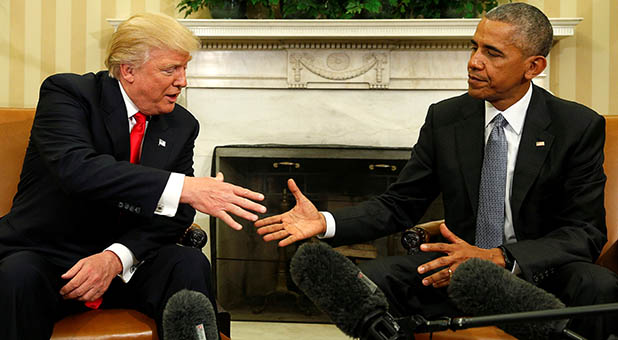73 Days: This Is What Has to Happen Between Election Day and Inauguration Day
The peaceful transition of power from one chief executive to another is one of the most enduring and cherished legacies of the American government. But it’s also a complicated process. There is a lot that has to happened in the 75 days between Election Day and Inauguration Day.
Here is a brief outline of some of the steps that have to be taken in the transition from President Obama to President Trump.
Nov. 9, 2016
Presidential campaigns usually create a transition team during the summer before the election. But starting today the president-elect is authorized by The Presidential Transition Act of 1963 to received funding to pay for his staff, secure office space, and pay for other expenses. The President’s FY2016 budget request included $13.278 million in funding for the transition.
Around this time, the transition team will create agency review teams, which as the Center for Presidential Transition explain, are responsible for “collecting information about the unique roles and responsibilities of each major department and agency of the federal government, and providing information that is relevant, useful and important to the new administration.”
The transition team also has to select the top 50 Cabinet appointees and key White House personnel, develop a policy implementation plan, budget and management agenda, send intended Cabinet agency appointments to the Senate, and figure out how to fill roughly 4,000 politically appointed positions (including more than 1,000 jobs requiring Senate confirmation).
They will also begin to draft new executive orders so that they can be implemented as soon as the president-elect takes office, and work with Office of Management and Budget (OMB) career staff to develop a “shadow” presidential budget aligned with the president-elect’s top policy priorities.
Mid-November through Dec. 19, 2016
Before the president-elect can take office, the Electoral College has to actually elect the president. The first step is for the governor of each state to prepare seven Certificates of Ascertainment, which lists the names of the Electors chosen by the voters and the number of votes received and the names of all other candidates for Elector and the number of votes received.
These documents are to be prepared “as soon as practicable” after the election results in each state are certified. Once completed, the governor sends one of the Certificates of Ascertainment to the Archivist at the National Archives and Records Administration.
Dec. 13, 2016
Any final decisions about the appointment of their electors must be resolved by this day (six days before the meeting of the Electors). This is so the electoral votes of each state will be presumed valid when presented to Congress.
Dec. 19, 2016
The Electors meet in their state and vote for president and vice president on separate ballots. The electors then record their votes on six “Certificates of Vote,” which are paired with the six remaining Certificates of Ascertainment that were issued by the governor and a copy sent to various officials (the president of the senate, the vice president, the presiding judge in the district where the Electors met, etc.).
Dec. 28, 2016
Electoral votes (the Certificates of Vote) must be received by the president of the Senate and the archivist by today (no later than nine days after the meeting of the electors).
Jan. 6, 2017
The Congress meets in joint session to count the electoral votes. The vice president, as president of the Senate, presides over the count and announces the results of the Electoral College vote. The president of the Senate, Joe Biden, then declares that Donald Trump and Mike Pence have been elected president and vice president of the United States.
Mid-January
The transition team will be submit agency review reports and brief incoming agency heads, prepare a Cabinet orientation/retreat, and take care of other last-minute items. President-elect Trump will also likely get a tour of his new home and office from President Obama.
Jan. 20, 2017 at Noon—Inauguration Day
The President-elect takes the Oath of Office and becomes the president of the United States. {eoa}
Joe Carter is a senior editor at the Acton Institute. Joe also serves as an editor at the The Gospel Coalition, a communications specialist for the Ethics and Religious Liberty Commission of the Southern Baptist Convention, and as an adjunct professor of journalism at Patrick Henry College. He is the editor of the NIV Lifehacks Bible and co-author of How to Argue like Jesus: Learning Persuasion from History’s Greatest Communicator (Crossway).
This article was originally published at acton.org. Used with permission.














































